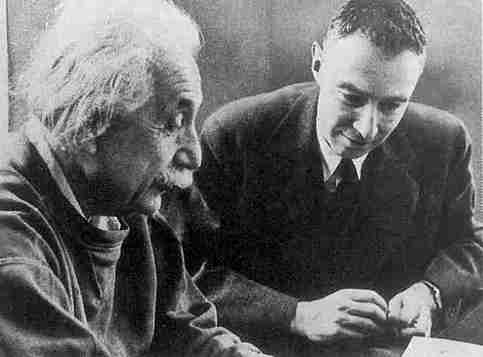
The modern theory of black holes begins with the 1939 paper by Oppenheimer and Snyder entitled `On continued gravitational contraction'. Their paper showed that if a stars collapsing core had sufficient mass, then even the neutron pressure would be insufficient to prevent further collapse to a black hole. This paper has strong claims to being one of the most prophetic ever written in this field of research. Today, 60 years later, this paper needs little revision - even the terminology is undated! In the abstract of the paper they wrote:
The star thus tends to close itself off from any communication with a distant observer; only its gravitational field persists
 |
When all the thermonuclear sources of energy are exhausted a sufficiently heavy star will collapse ... the radius of the star approaches asymptotically its gravitational radius; light from the star is progressively reddened, and can escape over a progressively narrower range of angles ... The total time of collapse for an observer co-moving with the stellar matter is finite... |
This description of gravitational collapse in an idealized case remains very much relevant today, and it indicates the inevitability of gravitational collapse at the end of the life of a massive star. Unfortunately, the importance of Oppenheimer and Snyder's paper would not be appreciated by their contemporaries. An important feature of the Oppenheimer-Snyder calculation was the idea from General Relativity that as a star becomes more compressed, the pressure itself adds to the gravitational attraction, so accelerating the collapse. Their work thus showed that Schwarzschild's black hole solution was not just a mathematical curiosity but a consequence of the gravitational collapse of a spherically symmetric star. However, because the calculations analysed stars with a high degree of symmetry, most physicists at the time were suspicious of the result and reluctant to take the idea seriously.
In the Newtonian theory of gravity, if a spherically symmetric shell of dust is released from rest then a singularity will be produced when all the matter simultaneously reaches the centre. However if things are not quite symmetrical then no singularity is formed. Thus, one might suspect that in General Relativity the formation of a singularity is a consequence of the spherical symmetry. As we will see below, the Penrose and Hawking singularity theorems showed that gravitational singularites are generic features of gravitational collapse.
|
War had already broken out in Europe when Oppenheimer and Snyder's paper appeared in print (September 1939). Oppenheimer's research group was dispersed. By 1941 he had been recruited for the Manhattan Project (and would be busy pursuing other aspects of Einstein's theories...). As a result the subject entered a dark age, from which it did not emerge until the 1950s. Here Oppenheimer is seen discussing science matters with Einstein.
|
 |
The subject of black holes was resucitated in the 1960's by two discoveries. The first was the mathematical discovery by Roy Kerr of a non-spherically symmetric solution of Einstein's equations which described a rotating black hole, now called the Kerr solution. The second was the observational discovery of quasars. By its very nature it is only possible to have indirect evidence of the existence of black holes. However a black hole causes considerable distortion to spacetime near the event horizon, and matter falling into the black hole is accelerated to speeds close to that of light. The nature of quasars is still one of the most debated topics in astrophysics but most astronomers now believe that they are galactic nuclei with supermassive black holes at their core.